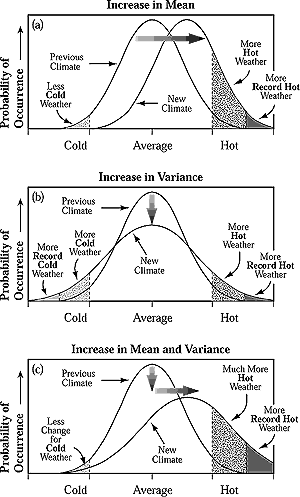8.2.2. Attribution Analyses of Loss Trends

Figure 8-2: Schematic showing effect on extreme temperatures when
(a) mean temperature increases, (b) variance increases, and (c) when both
mean and variance increase for a normal distribution of temperature (TAR
WGI, Figure 2.32). |
Weather-related events of all magnitudes resulted in US$707
billion in insured and uninsured economic losses between 1985 and 1999 (Munich
Re, 2000). A longer term comparison of large catastrophic events over the past
50 years reveals that economic losses (adjusted for inflation) increased by
a factor of 10.3 (Figure 8-1). Over this same period,
population grew by a factor of 2.4.
One of the vexing dilemmas in analyzing such historical data is disentangling
causal factors related to human-induced climatic change, natural variability,
and those having to do with human activity that could accelerate or dampen measured
impacts. Numerous human factors are in operation that contribute to the upward
trends in real economic losses, including population growth, rising standard
of living, urbanization and industrialization in high-risk regions, vulnerability
of modern societies and technologies, environmental degradation, penetration
of insurance, and changing societal attitudes toward compensation (the latter
two factors may lead to an increase in losses reported). Data on the numbers
of events also show an increase in many cases. The number of disasters (defined
as annual requests from states for federal disaster declarations) has roughly
doubled in the United States since the early 1980s (Anderson, 2000). It is relevant
to note here that such requests involve considerations of significant social
effects (Kunkel et al., 1999); as a consequence, it is an indirect and
subjective proxy for the frequency of events.
Growth trends in non-climate-related losses have been relatively constant over
the past 3 decades. Losses from human-induced catastrophes have remained relatively
constant (Swiss Re, 1999a). Earthquake losses have increased, but more slowly
than weather-related losses (Bruce et al., 1999). The number of disasters
causing more than 1% GDP damage to affected countries has increased two to three
times as rapidly for weather-related disasters as for earthquakes in the period
1963-1992 (United Nations, 1994).
Insurers have pointed out that local environmental factors such as soil degradation,
loss of biodiversity, lack of drinkable water, pollution, deforestation, forest
degradation, and land-use changes can amplify the impacts of weather-related
catastrophes (Zeng and Kelly, 1997). As an illustration, the extent of flood
losses from Hurricane Mitch was attributed in part to deforestation in Central
America.
Attempts to analyze the underlying causes of trends in natural disasters also
must allow for the effects of human activities that offset growth factors (Kunkel
et al., 1999). A considerable leveling off or reduction in loss of life
during U.S. disasters is one indicator that mitigation has been effective (Easterling
et al., 2000a). Loss-reduction efforts—typically unaccounted for
in analyses we have seen—include considerable efforts to avert or reduce
natural disaster impacts (e.g., coastal protection structures along coastlines;
cloud seeding to deflect hailstorms; improved building codes; tightened land-use
zoning; enhanced fire-suppression capacity; improved weather forecasts and early-warning
systems; and improved disaster preparedness, response, and recovery). Within
the insurance arena, increasing deductibles (the initial tier of loss costs
paid for by the insured) and withdrawal of coverage from particularly high-risk
areas have reduced observed losses. The literature has not attempted to quantify
the contribution of these activities.
The relative contributions of human and climatic factors to the changing patterns
of losses varies, depending on place and type of event (see Table
8-1; also see Easterling et al., 2000a,b for a review). U.S. studies
have found that demography largely explains increases in losses for hurricanes,
wind, hail, and tornado events, whereas winter storm damage has mixed causation
(Pielke and Landsea, 1998; Changnon, 1999; Changnon and Changnon, 1999; Kunkel
et al., 1999). In addition, decadal-scale trends have been discerned
for tropical cyclones. There is good evidence that the intensity and frequency
of precipitation and flood-related extreme events in the United States is increasing
(Zeng and Kelly, 1997; Karl and Knight, 1998; Pielke and Downton, 2000). This
trend also has been found for precipitation in many other parts of the world
(see Chapter 3). In a study of hailstorms in France, Dessens
(1995) used insurance loss information as a proxy for storm occurrence and found
a statistically significant upward trend between 1946 and 1990.
In one global analysis, Munich Re (1999b) estimates that economic losses from
large natural disasters increased two-fold between the 1970s and 1990s, after
correcting for inflation, insurance penetration and pricing effects, and increases
in the material standard of living. A similar result was reported for UK buildings
in the SAR (Dlugolecki et al., 1996).
Based on the findings of TAR WGI, the information summarized in Table
8-1, and the analysis presented above, we conclude that some part of the
upward trend in the cost of weather-related disasters illustrated in Figure
8-1 is linked to socioeconomic factors (increased wealth, shifts of population
to the coasts, etc.) and some part is linked to climatic factors such as observed
changes in precipitation and drought events. There are regional differences
in the balance of these two causes.
|